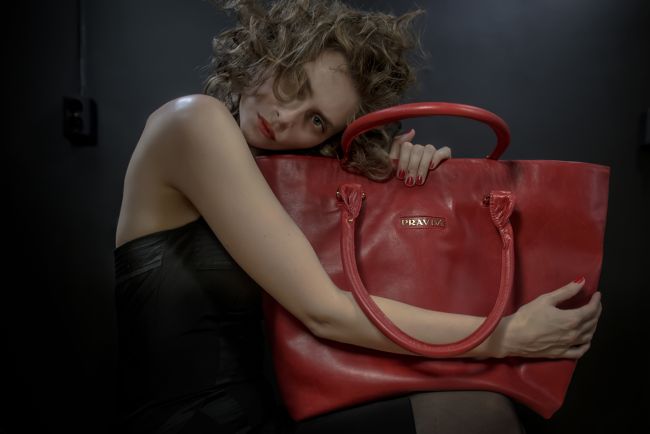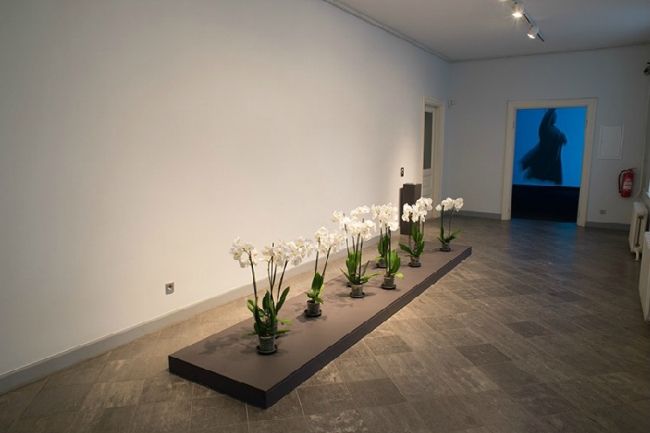
PRADA PRAVDA in Tartu. An Interview with Curators
Annika Toots
24/09/2013
Photos: Madis Katz
PRADA PRAVDA
Tartu Art Museum (Raekoja plats 18), Noorus Gallery (Riia 11) and Y-gallery (Küütri 2)
September 5 t0 October 27, 2013
From September 5 to October 27 the 4th Contemporary Art Festival ART IST KUKU NU UT takes place in Tartu. This year’s exhibition, an experimental cooperation project, is titled PRADA PRAVDA, and simultaneously takes place in three exhibition spaces: the Tartu Art Museum, Noorus Gallery and Y-gallery. In addition to the festival's main organizers, Rael Artel and Kaisa Eiche, this year's exhibition curators also include Marika Agu, Triin Tulgiste, and Marie Vellevoog, students of the curatorship school KUKU NUNNU, launched just this year. The young curators answered some questions about their experience and about the concept of the exhibition.

Promo photo of PRADA PRAVDA by Gabriela Liivamägi
The main curators have claimed that the curatorship school is essentially a learning-by-doing method. What was the role of the students in the process of organizing a big-scale art festival, and what kind of knowledge did you gain from this?
Marie Vellevoog: We were involved in organizing the festival almost from the beginning, and we were exposed to all sorts of different tasks, which were not confined only to curatorial work. First, we developed our own concepts and approaches to the subject of the exhibition. Since we are quite new in the world of curating and we lacked a wider acquaintanceship among foreign artists, we asked for advice and assistance from international curators. Neringa Černiauskaitė, Benjamin Fallon, Michal Jachula, Maija Rudovska, Claire Staebler and Vladimir Us gave us advice on which artists and works we should include. Quite a few of those recommendations ended up in the exhibition, but we also had to independently find artists who would suit our concept. This included extensive work on several exhibition catalogs and browsing the Internet. After finding the right works, we had to communicate with the artists or their galleries, agree on the terms of exhibiting, organize transport, etc. We acquired considerable experience in preparing a large-scale exhibition by just going through the whole process, and not being confined to only theory. Going through it gave us the valuable knowledge that curating an exhibition is not only delivering the works – this process also includes installing the works until 4 AM in the morning, filling and painting the walls, and much more. All of the lessons learned will definitely benefit us in organizing future exhibitions or other events.
ART IST KUKU NU UT has been defined as a location- and context-specific contemporary art festival. How do these qualities manifest themselves?
Marie VellevoogEvery year ART IST KUKU NU UT has been based on the previous developments in Estonia’s art field. In 2010, when the festival took place for the first time, the purpose of the introductory event was to map the cultural dynamics of Tartu. The subjective study culminated with a publication, which was then distributed in Tartu and all over Estonia. Taking into account the opinions and the expectations, a festival format that would suit Tartu in the present moment, in the 21st century, was sought.
This year’s exhibition is ambiguously titled PRADA PRAVDA. Could you tell a bit more about the concept and the purpose of the exhibition?
Marie Vellevoog: ART IST KUKU NU UT is a word game, and the names of the exhibitions are also word games. The word game PRADA-PRAVDA was invented by Rael Artel and Kaisa Eiche, and the fact that the fashion brand Prada, as well as the former communist gazette Pravda recently celebrated their 100th anniversary, contributed to the launch of the idea. Prada and Pravda allow a certain playful use of the east-west and communism-capitalism conflict, because the pair of words contains symbols of luxury, elitism, capitalism, consumption, totalitarian regime, colonialism, etc. However, each curator approached these words from their own point of view, which means that inside one large-scale exhibition, there are five different ones, which are not spatially separated from each other, but rather intermingle, overlap at times, and create a variety of new relationships.
Marika Agu: This year’s festival’s subject PRADA PRAVDA presents a seemingly simple dilemma in art reception – whether to prefer something “beautiful” or something that expresses the “truth”. The idea is to contribute to the discussion that emerged from Jaan Toomik’s work “15 May – 1 June 1992”, which was exhibited at the ART IST KUKU NU UT festival’s exhibition HUH? PFUI! YUCK! AHA! WOW!.
On what basis has the exhibition been divided between three different spaces?
Marie Vellevoog: The three different venues should be viewed as a whole. But we played a bit with the idea of galleries as different types of commercial space, which would interdigitate with the Prada side of the exhibition. Y-gallery became a boutique, Nooruse Gallery became a department store, and the Art Museum became an antique store. The art works were divided between the spaces following this concept. Is some ways it’s not a joke, because the Y-gallery space, which has a new owner, probably will turn into a boutique soon, and Noorus Gallery previously functioned as a sports equipment store.
What does the festival program include?
Marie Vellevoog: The important accompanying element is a comprehensive catalogue that includes guide texts about all of the works exhibited, so if you’re visiting the exhibition, it’s worth buying – there is exciting additional information about many of the works, which helps the viewer in the process of interpretation. In addition, the catalogue includes the concepts of the curators, which explain more thoroughly the many directions stemming from the Prada-Pravda word game. The catalogue also includes a “Contemporary Art Special”, with a roundtable discussion on the term “contemporary art” and a translation of Giorgio Agamben’s essay “What is the Contemporary?”.
Triin Tulgiste: This year’s education program will focus on the presentation of the different viewpoints of the curators and the artists. This means less lectures than last year, and more interviews with the artists and curators, and guided tours. In addition, this year we also cooperated with Semiosalong, which organizes a workshop of art criticism for young students of semiotics.
What’s going to happen next year? Will the new curators inherit all of the joys and pains of organizing a contemporary art festival?
Marie Vellevoog: It’s too early to talk about the future. We’ll think about it when this year’s exhibition is over.







